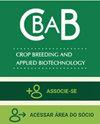Obtaining okra hybrids through partial diallel analysis
IF 1.1
4区 农林科学
Q2 Agricultural and Biological Sciences
引用次数: 1
Abstract
The exploration of heterosis can be an efficient alternative to increase okra yield. The partial diallel strategy optimizes resources by guiding crosses based on genetic diversity between various genotypes. This study aimed to identify potential hybrid combinations through diallel analysis in comparison with commercial cultivars. The hybrids were evaluated by means of a partial diallel scheme based on the genetic divergence of the genotypes. Fourteen hybrids and their reciprocals were evaluated in the winter and summer conditions of Jaboticabal – SP for yield, number of fruits and precocity. No line showed significant general combining ability. The reciprocal effect was not significant for the evaluated characteristics. Four hybrid combinations showed significant and positive specific combining ability for number of fruits, which were considered promising hybrids. In the winter, the experimental hybrids 1 x 8 and 3 x 8 showed superior performance compared to the commercial hybrids. No significant differences were observed in the summer.通过部分双列分析获得秋葵杂交种
探索杂种优势是提高秋葵产量的有效途径。部分双列策略是根据不同基因型之间的遗传多样性,通过引导杂交来优化资源。本研究旨在通过与商品品种的双列杂交分析,确定潜在的杂交组合。根据基因型的遗传差异,采用部分双列杂交方法进行鉴定。在冬季和夏季条件下,对14个Jaboticabal - SP杂交种及其后代的产量、果数和早熟性进行了评价。没有品系表现出显著的一般配合力。评价性状的互反效应不显著。4个杂种组合的果实数特异配合力显著且为正,是有发展前途的杂种组合。在冬季,试验杂交种1 × 8和3 × 8表现出优于商品杂交种的性能。在夏季没有观察到显著差异。
本文章由计算机程序翻译,如有差异,请以英文原文为准。
求助全文
约1分钟内获得全文
求助全文
来源期刊
CiteScore
2.40
自引率
13.30%
发文量
25
审稿时长
6-12 weeks
期刊介绍:
The CBAB – CROP BREEDING AND APPLIED BIOTECHNOLOGY (ISSN 1984-7033) – is the official quarterly journal of the Brazilian Society of Plant Breeding, abbreviated CROP BREED APPL BIOTECHNOL.
It publishes original scientific articles, which contribute to the scientific and technological development of plant breeding and agriculture. Articles should be to do with basic and applied research on improvement of perennial and annual plants, within the fields of genetics, conservation of germplasm, biotechnology, genomics, cytogenetics, experimental statistics, seeds, food quality, biotic and abiotic stress, and correlated areas. The article must be unpublished. Simultaneous submitting to another periodical is ruled out. Authors are held solely responsible for the opinions and ideas expressed, which do not necessarily reflect the view of the Editorial board. However, the Editorial board reserves the right to suggest or ask for any modifications required. The journal adopts the Ithenticate software for identification of plagiarism. Complete or partial reproduction of articles is permitted, provided the source is cited. All content of the journal, except where identified, is licensed under a Creative Commons attribution-type BY. All articles are published free of charge. This is an open access journal.

 求助内容:
求助内容: 应助结果提醒方式:
应助结果提醒方式:


